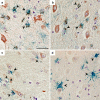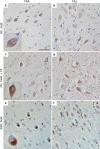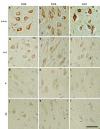Accumulation of intraneuronal Abeta correlates with ApoE4 genotype
- PMID: 20217101
- PMCID: PMC2849938
- DOI: 10.1007/s00401-010-0666-1
Accumulation of intraneuronal Abeta correlates with ApoE4 genotype
Abstract
In contrast to extracellular plaque and intracellular tangle pathology, the presence and relevance of intraneuronal Abeta in Alzheimer's disease (AD) is still a matter of debate. Human brain tissue offers technical challenges such as post-mortem delay and uneven or prolonged tissue fixation that might affect immunohistochemical staining. In addition, previous studies on intracellular Abeta accumulation in human brain often used antibodies targeting the C-terminus of Abeta and differed strongly in the pretreatments used. To overcome these inconsistencies, we performed extensive parametrical testing using a highly specific N-terminal Abeta antibody detecting the aspartate at position 1, before developing an optimal staining protocol for intraneuronal Abeta detection in paraffin-embedded sections from AD patients. To rule out that this antibody also detects the beta-cleaved APP C-terminal fragment (beta-CTF, C99) bearing the same epitope, paraffin-sections of transgenic mice overexpressing the C99-fragment were stained without any evidence for cross-reactivity in our staining protocol. The staining intensity of intraneuronal Abeta in cortex and hippocampal tissue of 10 controls and 20 sporadic AD cases was then correlated to patient data including sex, Braak stage, plaque load, and apolipoprotein E (ApoE) genotype. In particular, the presence of one or two ApoE4 alleles strongly correlated with an increased accumulation of intraneuronal Abeta peptides. Given that ApoE4 is a major genetic risk factor for AD and is involved in neuronal cholesterol transport, it is tempting to speculate that perturbed intracellular trafficking is involved in the increased intraneuronal Abeta aggregation in AD.
Figures




Similar articles
-
Human APOE genotype affects intraneuronal Aβ1-42 accumulation in a lentiviral gene transfer model.Hum Mol Genet. 2014 Mar 1;23(5):1365-75. doi: 10.1093/hmg/ddt525. Epub 2013 Oct 23. Hum Mol Genet. 2014. PMID: 24154541 Free PMC article.
-
Formic acid is essential for immunohistochemical detection of aggregated intraneuronal Abeta peptides in mouse models of Alzheimer's disease.Brain Res. 2009 Dec 8;1301:116-25. doi: 10.1016/j.brainres.2009.09.014. Epub 2009 Sep 12. Brain Res. 2009. PMID: 19751708
-
Intraneuronal amyloid-beta plays a role in mediating the synergistic pathological effects of apoE4 and environmental stimulation.J Neurochem. 2007 Nov;103(3):1031-40. doi: 10.1111/j.1471-4159.2007.04810.x. Epub 2007 Jul 31. J Neurochem. 2007. PMID: 17666042
-
Cellular cholesterol homeostasis and Alzheimer's disease.J Lipid Res. 2017 Dec;58(12):2239-2254. doi: 10.1194/jlr.R075630. Epub 2017 Mar 15. J Lipid Res. 2017. PMID: 28298292 Free PMC article. Review.
-
Soluble apoE/Aβ complex: mechanism and therapeutic target for APOE4-induced AD risk.Mol Neurodegener. 2014 Jan 4;9:2. doi: 10.1186/1750-1326-9-2. Mol Neurodegener. 2014. PMID: 24386905 Free PMC article. Review.
Cited by
-
Spine pruning in 5xFAD mice starts on basal dendrites of layer 5 pyramidal neurons.Brain Struct Funct. 2014 Mar;219(2):571-80. doi: 10.1007/s00429-013-0518-6. Epub 2013 Feb 17. Brain Struct Funct. 2014. PMID: 23417057 Free PMC article.
-
Apolipoprotein E as a Therapeutic Target in Alzheimer's Disease: A Review of Basic Research and Clinical Evidence.CNS Drugs. 2016 Sep;30(9):773-89. doi: 10.1007/s40263-016-0361-4. CNS Drugs. 2016. PMID: 27328687 Free PMC article. Review.
-
Dyslipidemia and dementia: current epidemiology, genetic evidence, and mechanisms behind the associations.J Alzheimers Dis. 2012;30 Suppl 2(0 2):S127-45. doi: 10.3233/JAD-2011-110599. J Alzheimers Dis. 2012. PMID: 21965313 Free PMC article. Review.
-
The Role of Non-coding RNAs in Alzheimer's Disease: Pathogenesis, Novel Biomarkers, and Potential Therapeutic Targets.CNS Neurol Disord Drug Targets. 2024;23(6):731-745. doi: 10.2174/1871527322666230519113201. CNS Neurol Disord Drug Targets. 2024. PMID: 37211844 Review.
-
APOE deficiency inhibits amyloid-facilitated (A) tau pathology (T) and neurodegeneration (N), halting progressive ATN pathology in a preclinical model.Mol Psychiatry. 2025 Apr 30. doi: 10.1038/s41380-025-03036-7. Online ahead of print. Mol Psychiatry. 2025. PMID: 40307424
References
Publication types
MeSH terms
Substances
LinkOut - more resources
Full Text Sources
Medical
Miscellaneous

